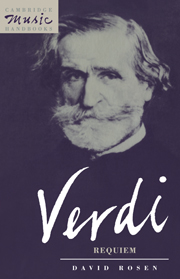Book contents
- Frontmatter
- Contents
- Preface
- 1 The genesis of the Messa da Requiem per l' anniversario della morte di Manzoni 22 maggio 1874
- 2 The premiere, subsequent performance history, and performing practices
- 3 Requiem e Kyrie
- 4 Dies iræ
- 5 Offertorio
- 6 Sanctus
- 7 Agnus Dei
- 8 Lux æterna
- 9 The Libera me and its genesis
- 10 Two revisions
- 11 The unità musicale of the Requiem
- 12 A question of genre
- Notes
- Select bibliography
- Index
11 - The unità musicale of the Requiem
Published online by Cambridge University Press: 04 February 2010
- Frontmatter
- Contents
- Preface
- 1 The genesis of the Messa da Requiem per l' anniversario della morte di Manzoni 22 maggio 1874
- 2 The premiere, subsequent performance history, and performing practices
- 3 Requiem e Kyrie
- 4 Dies iræ
- 5 Offertorio
- 6 Sanctus
- 7 Agnus Dei
- 8 Lux æterna
- 9 The Libera me and its genesis
- 10 Two revisions
- 11 The unità musicale of the Requiem
- 12 A question of genre
- Notes
- Select bibliography
- Index
Summary
‘The composition (however good the individual numbers may be) will necessarily lack unità musicale’, Verdi wrote in his letter proposing the Messa per Rossini. Earlier that year he had rehearsed the shortcomings of primo ottocento opera, regretting ‘above all, the lack of that golden thread that connects every part and constitutes - rather than unconnected, individual pieces [pezzi incoerenti] - an opera in music’. And nearly fifteen years earlier he had expressed his belief ‘that you can make twenty pieces of good music that make a bad work when put together. A work composed by many composers, even if they are all geniuses, will always turn out without unity, without character, without style, and above all, there won't be a principal idea that reigns over and dominates the whole composition.’
In the Requiem the most obvious source of coherence - let us choose that translation of ‘unità’ rather than the more militant ‘unity’ - comes from the system of reprises of the ‘Requiem aeternam’ and the ‘Dies irae’. The reappearance in the final movement of music heard earlier is not only a common procedure in nineteenth-century music in general but also has precedents in other Requiems, including the Requiems of Michael Haydn, Paisiello, Mozart/Süssmayr, and Berlioz. The function of the reprises is not merely to impart coherence, however, as they also have consequences for the expressive plot of the work.
- Type
- Chapter
- Information
- Verdi: Requiem , pp. 80 - 88Publisher: Cambridge University PressPrint publication year: 1995

